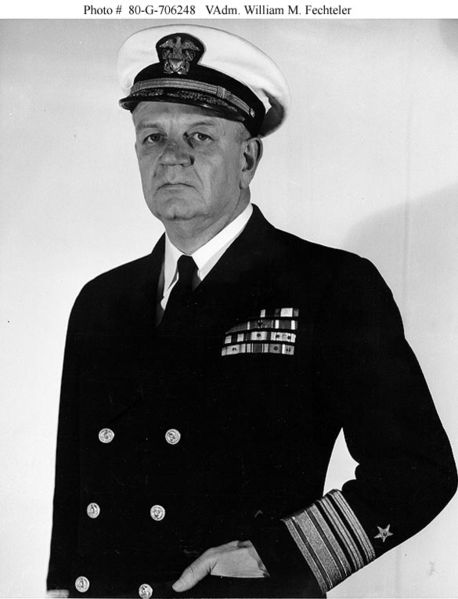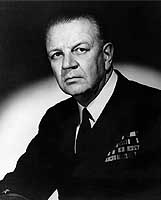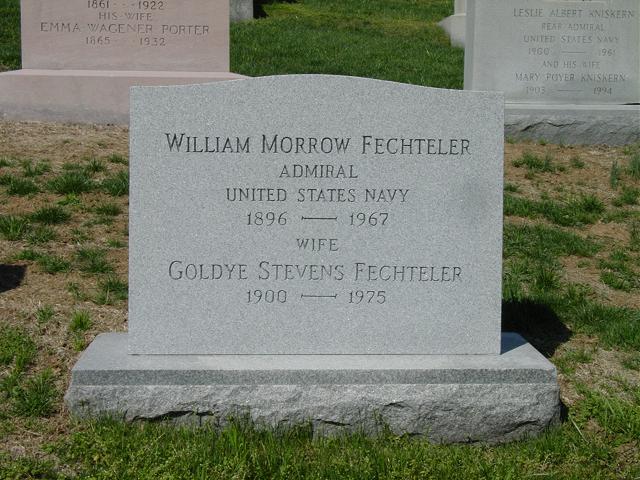Born in San Rafael, California, March 6, 1896, the son of Augustus Francis Fechteler, he graduated from the United States Naval Academy in 1916.

He served on the battleship USS Pennsyvlania during World War I and progressed through the regular alterntion of sea and shore duties, advancing to Captain and the post of Operations Office of Destroyer Command, Battle Forces, United States Fleet, by the outbreak of World War II.
From early 1942 to mid-1943, was with the Bureau of Naval Personnel; from August 1943 to June 1944, he commanded the battleship USS Indiana in the Gilbert, New Hebrides, and Marshall Islands campaigns. He was promoted to Rear Admiral, then named Commander of Amphibious Group 8, 7th Fleet Amphibious Force, under Daniel E. Barby. He led this group in operations around New Guinea in the Spring of 1944 and, in Barby’s absence, commanded VII Force in the assault on Biak Island, May 27, and Sansapor, New Guinea, July 30. In the Philippines Campaign, he was responsible for the landings in southwestern Luzon, January 1945, and on Palawan in February.
In April 1945, he returned to staff duty in Washington and in January 1946 he was named Commander of Battleships and Cruisers, Atlantic Fleet, with the rank of Vice Admiral.
From February 1947 to January 1950, he was Deputy Chief of Naval Operations for Personnel. In Februry 1950, he was promoted to Full Admiral and made Commander of the Atlantic Fleet.
In August 1951, while awaiting Senate confirmation as NATO Commander in the North Atlantic, he was appointed Chief of Naval Operations, succeeding Admiral Forrest P. Sherman who had died of a heart attack while serving in that post. Fechteler served as CNO for two years and then became Commander-in-Chief of NATO forces in Southern Europe. He retired from active duty in July 1956 and was associated with the General Electric Company thereafter. He died on July 4, 1967 at Bethesda Naval Hospital and was buried in Section 2 of Arlington National Cemetery.
His wife, Goldye Stevens Fechteler, is buried with him.
His brother, Frank Caspar Fechteler, is buried in Section 1 of Arlington National Cemetery.
Admiral William M. Fechteler, USN (1896-1967) —
13th Chief of Naval Operations, 16 August 1951 – 17 August 1953
William Morrow Fechteler was born in San Rafael, California, on 6 March 1896, the son of Lieutenant (later Rear Admiral) Augustus F. Fechteler, USN. He graduated from the U.S. Naval Academy with the class of 1916 and served in the battleship Pennsylvania (BB-38) during World War I. Over the following two decades, Fechteler had a variety of seagoing and shore billets, including several staff positions and command of the destroyer Perry (DD-340).
In 1942-43, Captain Fechteler served in the Bureau of Navigation (later Bureau of Naval Personnel), then commanded the battleship Indiana (BB-58) in the Pacific. Promoted to the rank of Rear Admiral in early 1944, he was Commander of the Seventh Fleet’s Amphibious Group 8 from August 1944 to March 1945, participating in landings at Morotai, Leyte, Lingayen and elsewhere in the Philippines. He spent the rest of 1945 as Assistant Chief of Naval Personnel, in Washington, DC, followed by service as Commander, Battleships & Cruisers, Atlantic Fleet. As a Vice Admiral, he was Deputy Chief of Naval Operations, Personnel, from February 1947 until January 1950 and, as an Admiral, was Commander in Chief, Atlantic and U.S. Atlantic Fleet in February 1950 – August 1951.
In August 1951, Admiral Fechteler was appointed Chief of Naval Operations, succeeding Admiral Forrest P. Sherman, who had died in office in July. As CNO, Fechteler was responsible for sustaining Korean War era naval activities in the Far East and in the European area. He made two trips across the Atlantic in 1951-52 and one to Asia. He was able to continue the Navy’s building program for new aircraft carriers in the face of economy moves and to expand pay and benefits for the Navy’s people.
When the President Dwight D. Eisenhower took office in 1953, he chose to replace all the Armed Forces’ chiefs. In August 1953, Admiral Fechteler exchanged positions with the new CNO, Admiral Robert B. Carney, becoming Commander in Chief, Allied Forces, Southern Europe. He served at that command’s Naples headquarters until July 1956, when he retired. Over the next several years, Fechteler served on a special Defense Department study committee on personnel compensation and worked for the General Electric Company. Admiral William M. Fechteler died on 4 July 1967.
Michael Robert Patterson was born in Arlington and is the son of a former officer of the US Army. So it was no wonder that sooner or later his interests drew him to American history and especially to American military history. Many of his articles can be found on renowned portals like the New York Times, Washingtonpost or Wikipedia.
Reviewed by: Michael Howard


